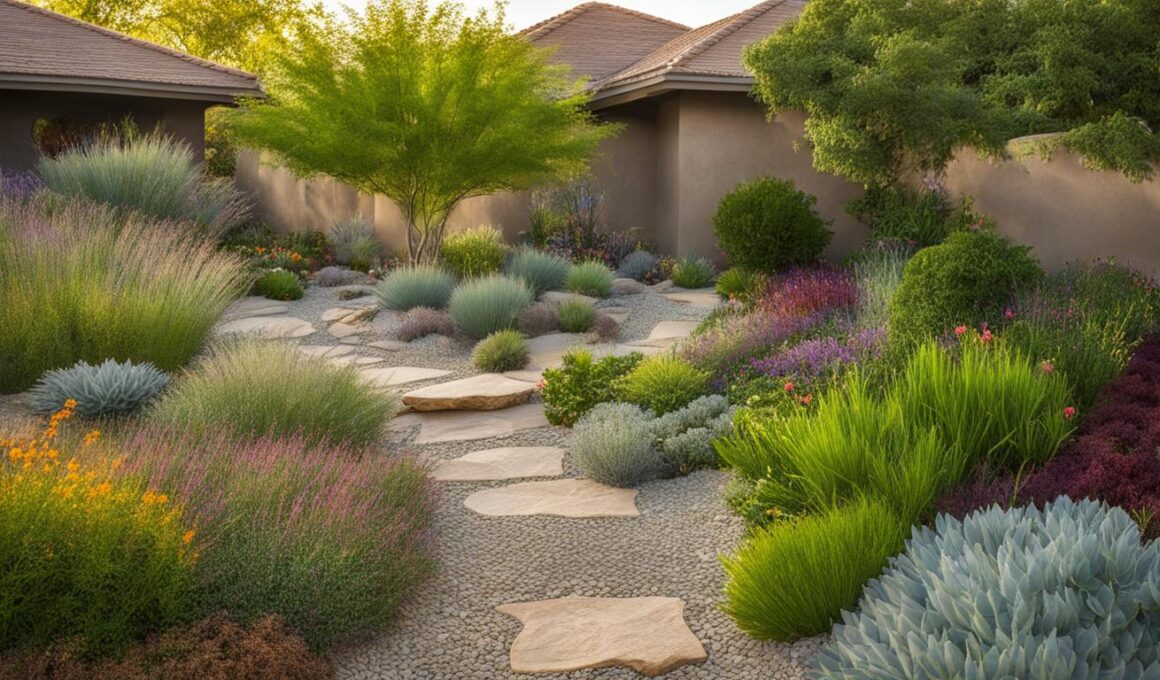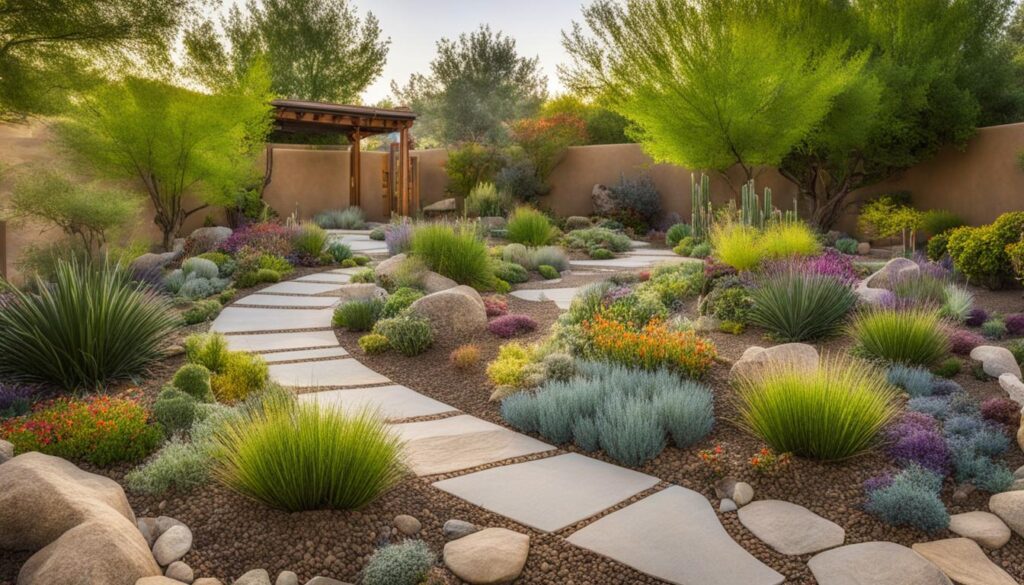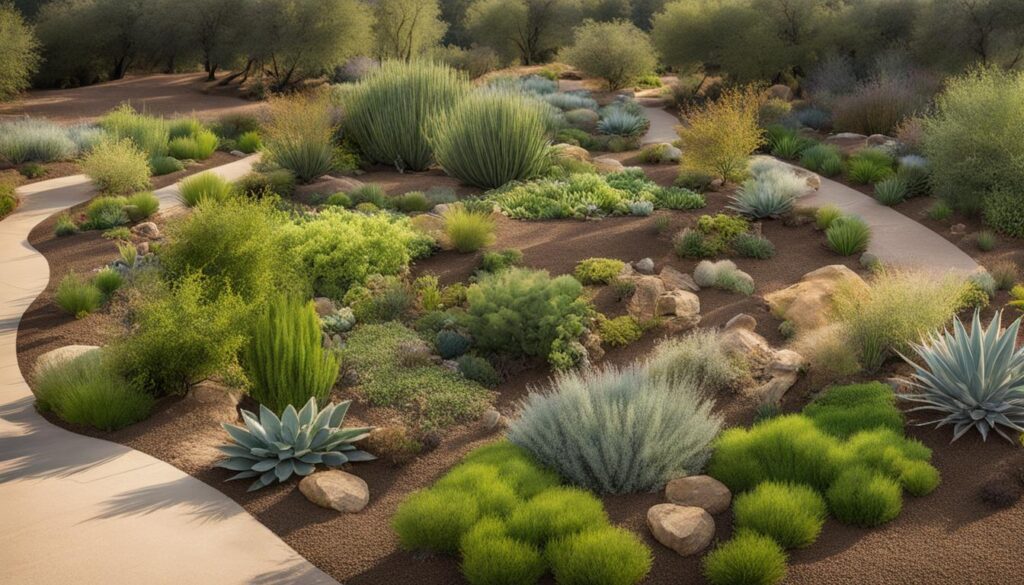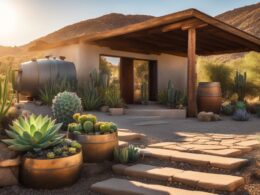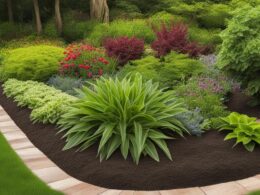Xeriscaping is an effective landscaping technique designed specifically for drought-prone areas. By implementing xeriscaping principles, you can create a beautiful and sustainable garden while conserving water. In this article, we will explore the key principles of xeriscaping, including water conservation, soil improvement, limited turf areas, use of native plants, mulching, efficient irrigation, and low maintenance. Let’s dive in and discover how you can transform your garden into a thriving oasis even in the face of drought.
Key Takeaways:
- Xeriscaping is a landscaping technique for drought-prone areas.
- Water conservation is a crucial principle of xeriscaping.
- Soil improvement is essential for creating a thriving xeriscape garden.
- Limiting turf areas and using native plants are important for water-efficient gardening.
- Xeriscaping offers benefits such as water conservation, low maintenance, and increased property value.
Water Conservation
Water conservation is a key principle of xeriscaping that allows you to create a thriving garden while reducing water usage. By carefully selecting drought-resistant plants and implementing efficient watering techniques, you can significantly reduce your water consumption.
One effective way to conserve water in your xeriscape garden is to choose drought-resistant plants that have adapted to survive in arid conditions. Grasses, cacti, and succulents are excellent options as they require minimal watering. These plants have specialized adaptations that allow them to store water and thrive in dry environments.
Proper planning and design are also crucial in water conservation. Understanding the water needs of different plants and grouping them accordingly can help optimize water usage. Creating terraces can prevent soil erosion while ensuring that water is effectively distributed throughout your garden. Additionally, using mulch can help retain moisture, reduce evaporation, and suppress weed growth.
Efficient Irrigation
Efficient irrigation practices play a vital role in water conservation. Drip irrigation systems and soaker hoses are excellent alternatives to traditional sprinkler systems as they target water directly to the plant’s root zone, minimizing water loss through evaporation. Additionally, using a timer and adjusting watering schedules based on weather conditions can further optimize water usage.
- Use drip irrigation or soaker hoses to target water directly to plant roots
- Install a timer to ensure watering at optimal times
- Adjust watering schedules based on weather conditions
Tips for Reducing Water Use
“Incorporate native plants into your xeriscape garden. Native plants are well-suited to your local climate and require less water to thrive.”
Implementing water conservation measures in your xeriscape garden not only helps conserve this precious resource but also reduces your water bills and promotes sustainability. By making conscious choices and adopting water-efficient practices, you can create a beautiful, drought-resistant garden that benefits both you and the environment.
Soil Improvement
In order to create a thriving xeriscape garden, it is essential to focus on soil improvement. The right soil conditions can greatly enhance the growth and health of xeriscape plants. When it comes to soil, two factors are crucial – moisture retention and drainage. The soil should be able to retain moisture while allowing excess water to drain quickly.
One effective method of improving soil moisture retention is by incorporating organic material, such as compost. Adding compost to the soil enhances its ability to retain moisture, providing a stable water source for the xeriscape plants. This organic matter also contributes to the overall fertility of the soil, providing necessary nutrients for plant growth. Organic material acts as a natural sponge, holding water in the soil longer, reducing the frequency of watering needed for your xeriscape garden.
“Using lean soil for cacti and succulents is essential.”
For cacti and succulents, it is important to use lean soil, which is well-draining and avoids excessive moisture retention. These plants are adapted to arid conditions and prefer soil that dries out quickly to prevent root rot. Testing the pH levels of the soil and making necessary amendments, such as adding rock phosphate and bone meal, can further enhance the fertility and energy levels of the soil for xeriscape plants.
By focusing on soil improvement, you can create the ideal growing environment for your xeriscape garden. The right soil conditions ensure that your plants receive the necessary nutrients and water they need to thrive in a drought-prone area, while also minimizing water wastage through proper drainage.
Key Points:
- Soil improvement is crucial for a thriving xeriscape garden.
- Incorporate organic material like compost to enhance soil moisture retention.
- Lean soil is ideal for cacti and succulents to prevent root rot.
- Test the soil’s pH levels and make necessary amendments to improve soil fertility.
Limited Turf Area and Use of Native Plants
When creating a xeriscape garden, it is important to limit the amount of turf area and prioritize the use of native plants. Instead of dedicating large portions of your garden to turf grass, consider if there are functional spaces where turf is truly necessary. By reducing the turf area, you can greatly minimize the water requirements of your garden and create a more sustainable landscape.
Native plants should be the stars of your xeriscape garden. These plants are naturally adapted to the local climate and soil conditions, making them more resilient and drought-resistant. They have evolved to thrive without excessive watering, making them an excellent choice for water-conserving landscapes. Native plants with small, thick leaves are especially well-suited for xeriscaping, as they have adapted to conserve water and withstand arid conditions.
Benefits of Limited Turf Area and Native Plants:
- Reduced water usage: Native plants require less water compared to traditional turf grass, helping to conserve water resources in drought-prone areas.
- Lower maintenance: Native plants are adapted to local conditions, reducing the need for fertilizers, pesticides, and intensive maintenance.
- Increased biodiversity: By using native plants, you create a habitat for local wildlife, supporting the diversity of birds, bees, butterflies, and other beneficial creatures.
- Improved soil health: Native plants have deep root systems that help improve soil structure and prevent erosion.
- Enhanced aesthetic appeal: Xeriscape gardens with native plants offer a unique and beautiful landscape, showcasing the natural beauty of the region.
By limiting turf area and incorporating native plants into your xeriscape garden, you can create a water-efficient and ecologically beneficial landscape that thrives in drought-prone areas. Embrace the natural beauty of your region and make a positive environmental impact through xeriscaping.
How Can I Apply Xeriscaping Principles in My Garden for Drought Resistance?
To create a drought-tolerant xeriscape garden, start by choosing native plants that thrive in your climate without much water. Incorporate layers of mulch to retain moisture and suppress weeds. Design the layout to group plants with similar water needs. Consider drip irrigation for efficient watering in your droughttolerant xeriscape garden layouts.
Overall Benefits of Xeriscape Gardening
Xeriscape gardening offers numerous benefits for homeowners. One of the primary advantages is water conservation. By implementing xeriscaping principles, you can drastically reduce your water usage compared to traditional gardening methods. In fact, xeriscape gardens can save up to 50-75% of water. This not only helps combat drought conditions in your area but also contributes to a more sustainable environment.
Another significant benefit of xeriscape gardening is low maintenance. Once established, these gardens require minimal effort to maintain. With the careful selection of drought-resistant plants and proper soil improvement techniques, you can enjoy a beautiful garden without the need for excessive watering, mowing, or the use of pesticides and fertilizers. This not only saves you time and energy but also reduces the overall cost of maintaining your outdoor space.
In addition to water conservation and low maintenance, xeriscape gardening can also increase your property value. As more homeowners become environmentally conscious, the demand for water-efficient landscapes is on the rise. A well-designed xeriscape garden can be seen as a valuable asset, enhancing the overall appeal and desirability of your property. This can translate into a higher resale value if you ever decide to sell your home.
By embracing xeriscape gardening, you are not only making a positive impact on the environment but also reaping the benefits of reduced water usage, low maintenance, and increased property value. Create a sustainable oasis in your own backyard while contributing to a greener future.





